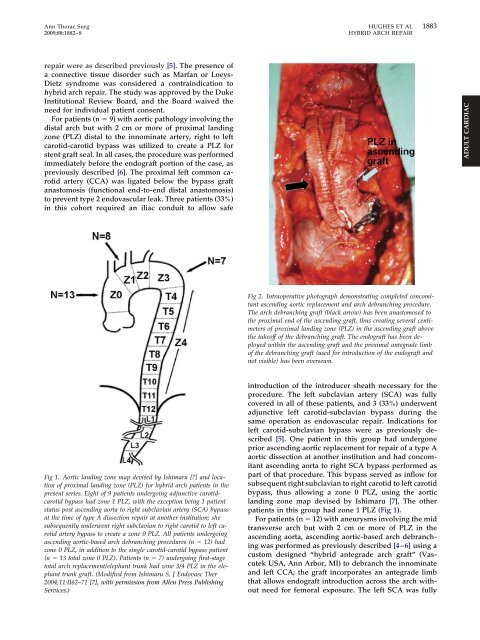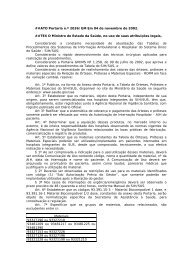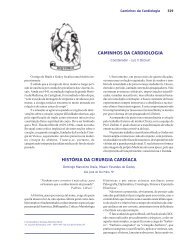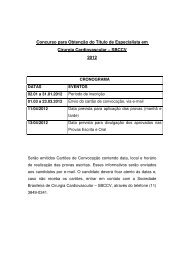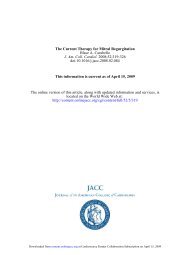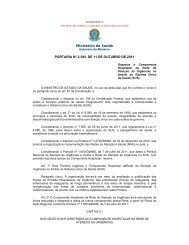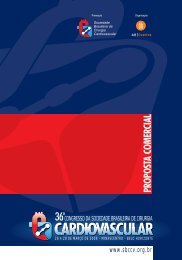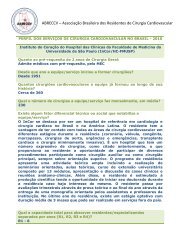“Hybrid” Repair of Aneurysms of the Transverse Aortic Arch: Midterm ...
“Hybrid” Repair of Aneurysms of the Transverse Aortic Arch: Midterm ...
“Hybrid” Repair of Aneurysms of the Transverse Aortic Arch: Midterm ...
You also want an ePaper? Increase the reach of your titles
YUMPU automatically turns print PDFs into web optimized ePapers that Google loves.
Ann Thorac Surg<br />
HUGHES ET AL<br />
2009;88:1882–8 HYBRID ARCH REPAIR<br />
1883<br />
repair were as described previously [5]. The presence <strong>of</strong><br />
a connective tissue disorder such as Marfan or Loeys-<br />
Dietz syndrome was considered a contraindication to<br />
hybrid arch repair. The study was approved by <strong>the</strong> Duke<br />
Institutional Review Board, and <strong>the</strong> Board waived <strong>the</strong><br />
need for individual patient consent.<br />
For patients (n 9) with aortic pathology involving <strong>the</strong><br />
distal arch but with 2 cm or more <strong>of</strong> proximal landing<br />
zone (PLZ) distal to <strong>the</strong> innominate artery, right to left<br />
carotid-carotid bypass was utilized to create a PLZ for<br />
stent graft seal. In all cases, <strong>the</strong> procedure was performed<br />
immediately before <strong>the</strong> endograft portion <strong>of</strong> <strong>the</strong> case, as<br />
previously described [6]. The proximal left common carotid<br />
artery (CCA) was ligated below <strong>the</strong> bypass graft<br />
anastomosis (functional end-to-end distal anastomosis)<br />
to prevent type 2 endovascular leak. Three patients (33%)<br />
in this cohort required an iliac conduit to allow safe<br />
ADULT CARDIAC<br />
Fig 2. Intraoperative photograph demonstrating completed concomitant<br />
ascending aortic replacement and arch debranching procedure.<br />
The arch debranching graft (black arrow) has been anastomosed to<br />
<strong>the</strong> proximal end <strong>of</strong> <strong>the</strong> ascending graft, thus creating several centimeters<br />
<strong>of</strong> proximal landing zone (PLZ) in <strong>the</strong> ascending graft above<br />
<strong>the</strong> take<strong>of</strong>f <strong>of</strong> <strong>the</strong> debranching graft. The endograft has been deployed<br />
within <strong>the</strong> ascending graft and <strong>the</strong> proximal antegrade limb<br />
<strong>of</strong> <strong>the</strong> debranching graft (used for introduction <strong>of</strong> <strong>the</strong> endograft and<br />
not visible) has been oversewn.<br />
Fig 1. <strong>Aortic</strong> landing zone map devised by Ishimaru [7] and location<br />
<strong>of</strong> proximal landing zone (PLZ) for hybrid arch patients in <strong>the</strong><br />
present series. Eight <strong>of</strong> 9 patients undergoing adjunctive carotidcarotid<br />
bypass had zone 1 PLZ, with <strong>the</strong> exception being 1 patient<br />
status post ascending aorta to right subclavian artery (SCA) bypass<br />
at <strong>the</strong> time <strong>of</strong> type A dissection repair at ano<strong>the</strong>r institution; she<br />
subsequently underwent right subclavian to right carotid to left carotid<br />
artery bypass to create a zone 0 PLZ. All patients undergoing<br />
ascending aortic-based arch debranching procedures (n 12) had<br />
zone 0 PLZ, in addition to <strong>the</strong> single carotid-carotid bypass patient<br />
(n 13 total zone 0 PLZ). Patients (n 7) undergoing first-stage<br />
total arch replacement/elephant trunk had zone 3/4 PLZ in <strong>the</strong> elephant<br />
trunk graft. (Modified from Ishimaru S, J Endovasc Ther<br />
2004;11:II62–71 [7], with permission from Allen Press Publishing<br />
Services.)<br />
introduction <strong>of</strong> <strong>the</strong> introducer sheath necessary for <strong>the</strong><br />
procedure. The left subclavian artery (SCA) was fully<br />
covered in all <strong>of</strong> <strong>the</strong>se patients, and 3 (33%) underwent<br />
adjunctive left carotid-subclavian bypass during <strong>the</strong><br />
same operation as endovascular repair. Indications for<br />
left carotid-subclavian bypass were as previously described<br />
[5]. One patient in this group had undergone<br />
prior ascending aortic replacement for repair <strong>of</strong> a type A<br />
aortic dissection at ano<strong>the</strong>r institution and had concomitant<br />
ascending aorta to right SCA bypass performed as<br />
part <strong>of</strong> that procedure. This bypass served as inflow for<br />
subsequent right subclavian to right carotid to left carotid<br />
bypass, thus allowing a zone 0 PLZ, using <strong>the</strong> aortic<br />
landing zone map devised by Ishimaru [7]. The o<strong>the</strong>r<br />
patients in this group had zone 1 PLZ (Fig 1).<br />
For patients (n 12) with aneurysms involving <strong>the</strong> mid<br />
transverse arch but with 2 cm or more <strong>of</strong> PLZ in <strong>the</strong><br />
ascending aorta, ascending aortic-based arch debranching<br />
was performed as previously described [4–6] using a<br />
custom designed “hybrid antegrade arch graft” (Vascutek<br />
USA, Ann Arbor, MI) to debranch <strong>the</strong> innominate<br />
and left CCA; <strong>the</strong> graft incorporates an antegrade limb<br />
that allows endograft introduction across <strong>the</strong> arch without<br />
need for femoral exposure. The left SCA was fully


